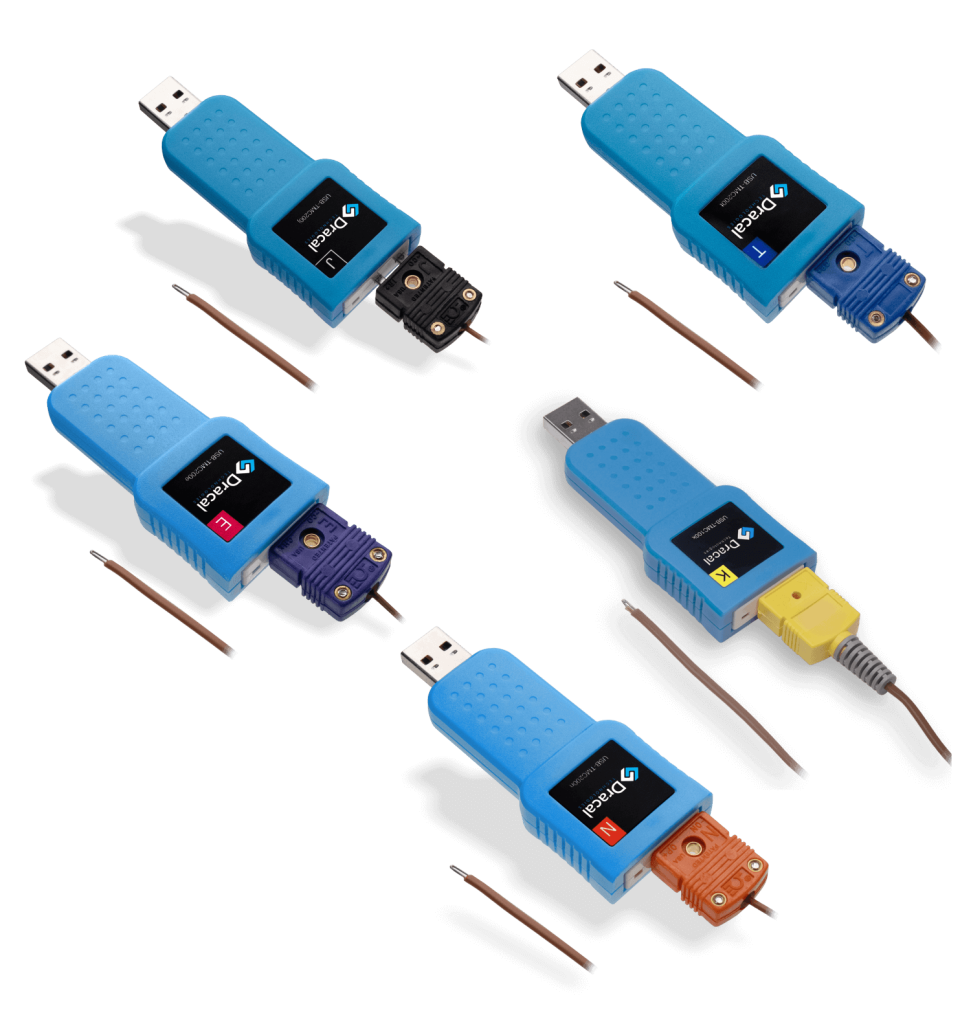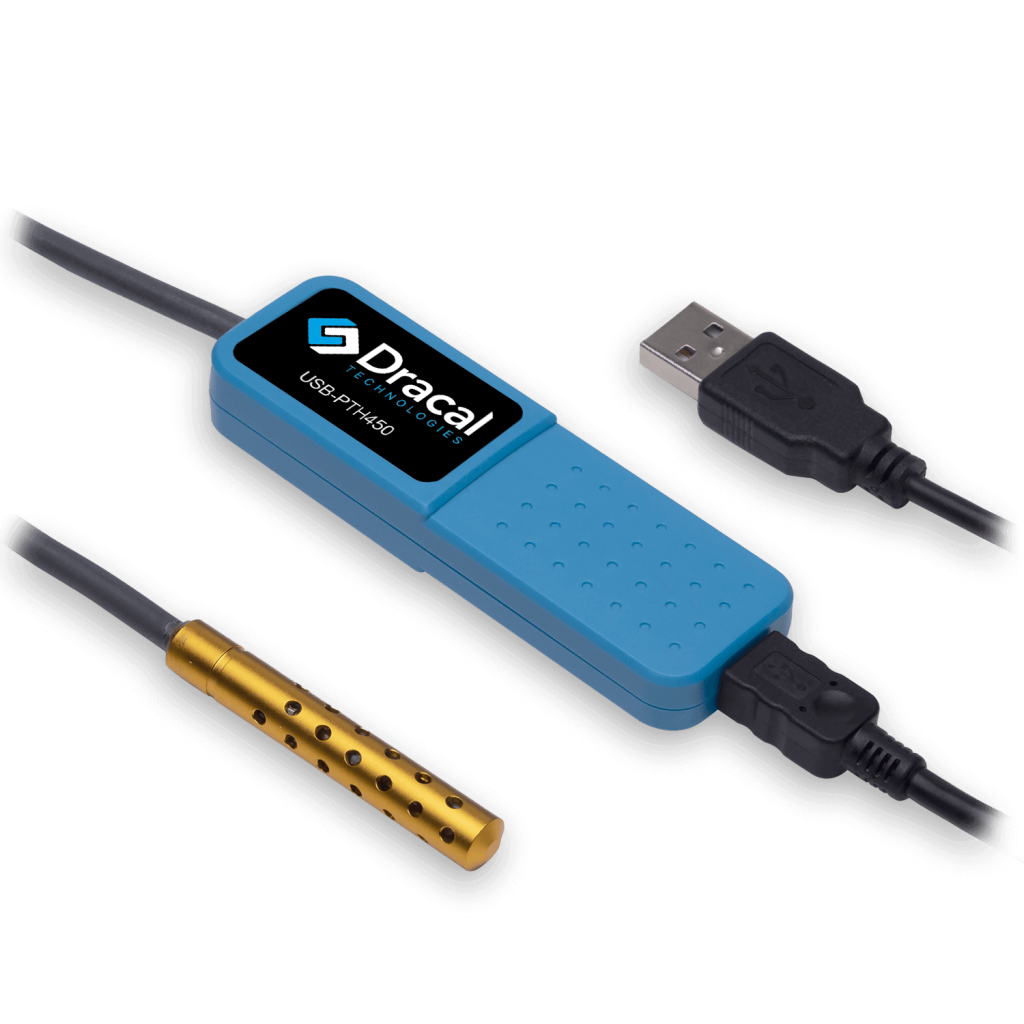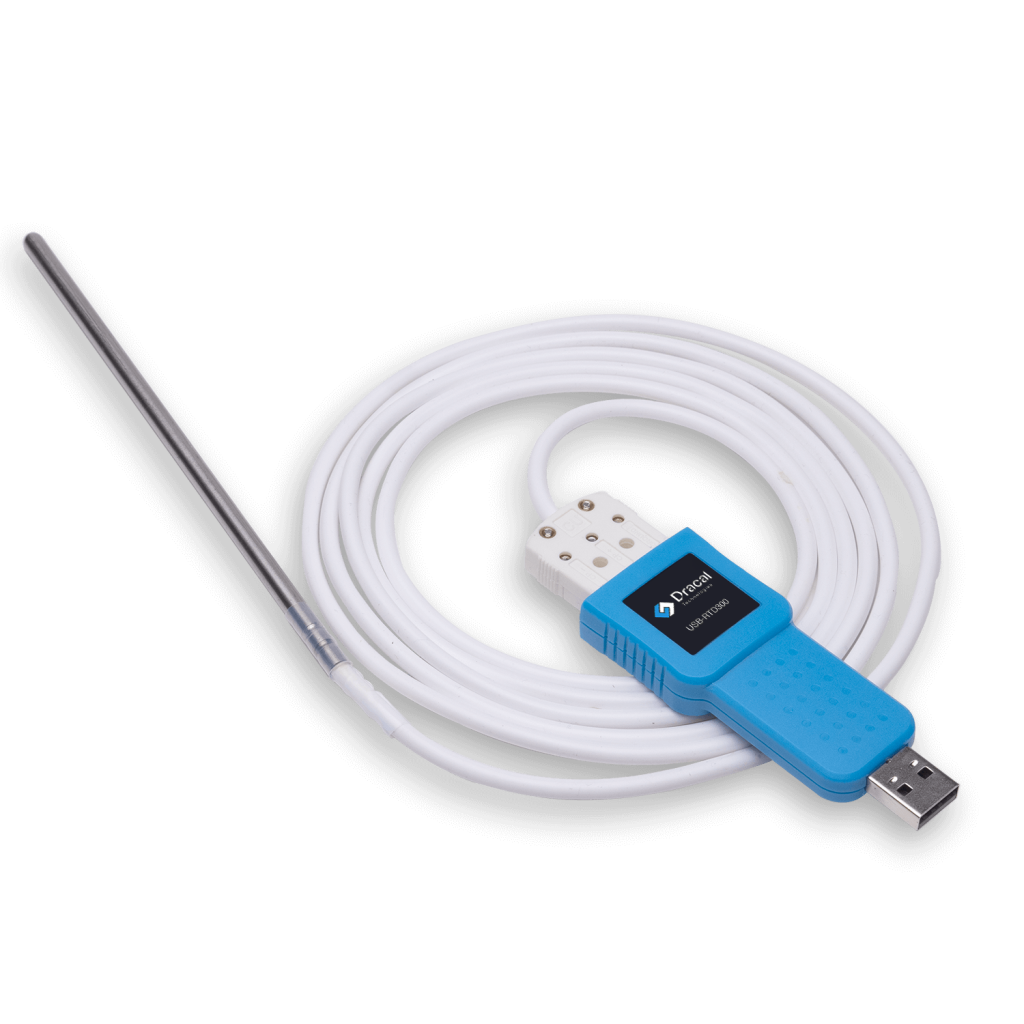How to choose the right USB temperature sensor
Choosing the right USB temperature sensor is essential to ensure accurate and reliable measurements. In this article, we will briefly explore the different families of temperature sensors: thermocouples, thermistors, and RTD probes. Each of these options has unique characteristics to meet specific temperature measurement needs. Then, we will name some functional considerations to save you time.
Whether you are a novice or an expert in the field, this guide will help you make an informed decision for your temperature measurement applications.

- What type of temperature sensor do I need?
- How much time do I have to set up a measurement system?
- What will my future needs be?
- The simplified solution for temperature data acquisition
What type of temperature sensor do I need?
There are three main families of temperature sensors: thermocouples, thermistors, and RTD probes. Each of these sensors is constructed differently and, therefore, offers different uses. Below, we will discuss the main characteristics of each.
We will talk about temperature sensors here, but if you’re interested in the anatomy of a sensor and details about the terminology used, we recommend checking out the article detailing what a Dracal measuring instrument is.
The thermocouple probe, for an instant response to temperature variations
The first type of temperature sensor is the thermocouple probe. Composed of two conductive metals joined at two junctions, a temperature variation generates an electrical potential at the hot junction of the thermocouple. The electrical signal must then be converted back into temperature.
The type of thermocouple probe offered by Dracal has an exposed tip, making it highly responsive to temperature changes. In addition to the probe itself, we also offer electrical signal converters that connect to a computer via a USB port. Together, the wired probe and the USB adapter form a USB temperature sensor.
Thermocouples are categorized into classes based on the type of metals used. Depending on the nature of these metals, thermocouples can withstand higher or lower temperatures and offer different levels of precision.
The most commonly used thermocouple class is type K, as it provides medium precision and covers a wide temperature range.
The thermocouple is a suitable probe if the measurement environment is stable, and you want to be able to instantly detect a temperature variation.
To learn more about Dracal’s thermocouple offerings, you can check out this short article on how to record temperature using a thermocouple.

The thermistor, for high-temperature sensitivity
A thermistor-type temperature sensor is made up of metal oxide semiconductors. The resistance of these metals varies with temperature. The type of metal used is not pure like in an RTD probe, but it gives the thermistor high sensitivity to temperature variations. This is the type of sensor used in digital temperature sensors like the SHT31 by Sensirion.
At Dracal, the thermistor is the type of temperature sensor we use in our PTH, TRH product ranges, and the TMP125, a precision thermometer. The PTH instruments offer an all-in-one solution, including a barometer, hygrometer, and precision thermometer. The TRH products are USB temperature and relative humidity sensors. Moreover, for a quick overview of the main features of each sensor in the TRH series, a selection guide is available.
Thermistor-type temperature sensors are more precise than thermocouples. They respond fairly quickly to temperature changes, although not as fast as thermocouples.
When choosing your temperature sensor, it is relevant to consider what is more important: response time in milliseconds or precision around 0.1°C. And if even higher precision is required, you will need an RTD probe.

The RTD probe, for unparalleled temperature measurement precision
An RTD (resistance temperature detector) probe is typically made of pure metal whose resistance changes with temperature. The most common RTD probes are made of platinum, with a resistance of 100 ohms at 0°C. The probe and its interpreter, such as one of the USB converters from Dracal Technologies, allow you to obtain much higher precision than thermistors. You could choose the probe offered by Dracal or not while having the option to use any of our USB converters for reliable and precise measurements. In fact, the precision of RTD converters is such that the instrument can be used for calibrating other thermometers or for monitoring environmental conditions for critical experiments with great precision.

Here is a summary table of the different USB temperature sensors offered by Dracal Technologies. Rest assured that Dracal’s offering includes not only sensors but a complete DAQ solution. This is why we believe that choosing a USB temperature sensor goes beyond technical considerations of precision and responsiveness; it also includes the time you will invest in making it work.
How much time do I have to set up a measurement system?
Your time is valuable. We understand that the measurement process is just one step in the development of your products or research. If you are considering a USB temperature sensor, it’s because you are already looking for a simple and effective solution. Now, let’s consider the factors for setting up this sensor.
How to simplify connecting a temperature sensor?
You already know: a USB port. Almost everything with a motherboard now has a USB port. No need to worry about faulty electrical connections; the USB port is user-friendly and safe. There are some practical considerations to ensure optimal installation and, thus, a flawless measurement system.
What if I could record my data in less than 3 minutes?
Now that your USB temperature sensor is properly connected, you will undoubtedly want to verify that it is working. Nothing could be simpler with Dracal’s tools, including the user-friendly interface DracalView. Visualize your measurements in real time and start a logging task in 4 clicks. Skeptical? This video will convince you.
And if I already have a system in place, can I add my USB temperature sensor?
If you already have an existing measurement system, you may be using LabVIEW (National Instruments). In the Dracal toolkit, there are command-line tools and all the documentation you need for their use, including a tutorial for LabVIEW.
Alternatively, you may be familiar with the VCP communication protocol. Dracal measurement instruments are available with this protocol as an option. The documentation available on the website can guide you in no time to start your data acquisition. If you want to learn more about the advantages of VCP mode, we invite you to check out this short list.
What will my future needs be?
It can be challenging to imagine an answer to this question. To ensure simplicity if you want to transition from a single temperature sensor to a complete measurement system, we recommend thinking in terms of a DAQ system (data acquisition solution) rather than just a USB temperature data logger. Furthermore, to ensure that you invest time and money in a durable system, here are some criteria to consider.
How can I easily expand my measurement system?
If you have chosen a DAQ solution, it will be easy to add various USB sensors to your system. However, make sure that your sensors provide harmonized data, regardless of the sensor type (temperature, CO2, relative humidity, etc.). The reason is simple: this will save you valuable hours of data alignment. With a logging file where all data is timestamped and each sensor is polled at the same frequency, the time normally lost in aligning data is reduced to zero.
If your needs lead you toward a wireless solution or even the construction of a data acquisition network, it is possible with USB sensors and the SensGate. This remote logging station is a wireless gateway between Dracal USB sensors and the computer where recordings are initiated. It has 7 USB ports, allowing for the simultaneous acquisition of various parameters, always in 4 clicks.
The simplified solution for temperature data acquisition
The very reason for Dracal’s existence is to positively contribute to accelerating progress in science and engineering. To do so, we offer a simple, accurate, accessible, and robust data acquisition solution. Getting Dracal USB temperature sensors ensures that you won’t waste time setting up a measurement system or expanding it if necessary. Furthermore, with the variety of instruments available, you can find the USB temperature sensor with the technical features you need, along with several other USB sensors.
Always offered at no extra charge with our products!
EASY TO USE IN YOUR OWN SYSTEM
- Ready-to-use, accurate and robust real-time data flow
- Choose the interface that works best for you (CLI, virtual COM, REST API)
- Code samples available in 10+ programming languages (Python, C/C++, C#, Java, Node, .Net, etc.)
- Operates under Windows, Mac OS X and Linux
- Usable with LabView (CLI guide, Virtual COM guide)
- All tools packaged within one simple, free of charge, DracalView download
FREE DATA VISUALIZATION, LOGGING AND CALIBRATION SOFTWARE
- Get up-and-running in less than 3 minutes
- Operates under Windows, Mac OS X and Linux
- Real-time on-screen graphing and logging
- Log interval down to 0.5 second and configurable units (°C, °F, K…)
- Simultaneous use of unlimited Dracal sensors supported
- Simple user-calibration (products with the -CAL option)
- Connectivity with SensGate Wi-Fi/Ethernet gateway

Conclusion
In conclusion, remember that taking the time to choose the best solution for your project will allow you to move forward quickly and confidently. So, the answer to the question is simple: evaluate the technical characteristics necessary for your project and make sure that operating the chosen USB temperature sensor will be as easy as child’s play.
Not sure if your project will benefit from Dracal’s solution?
Contact us, tell us about your project, and we’ll quickly determine if there’s a fit.
"*" indicates required fields